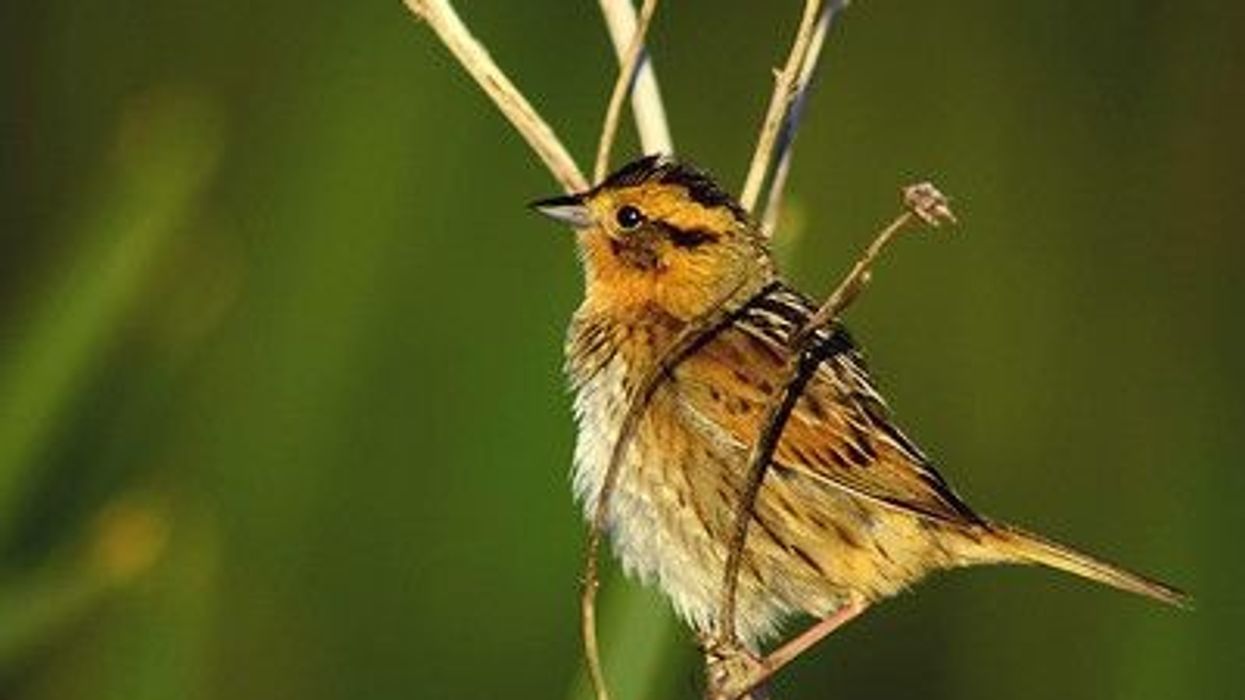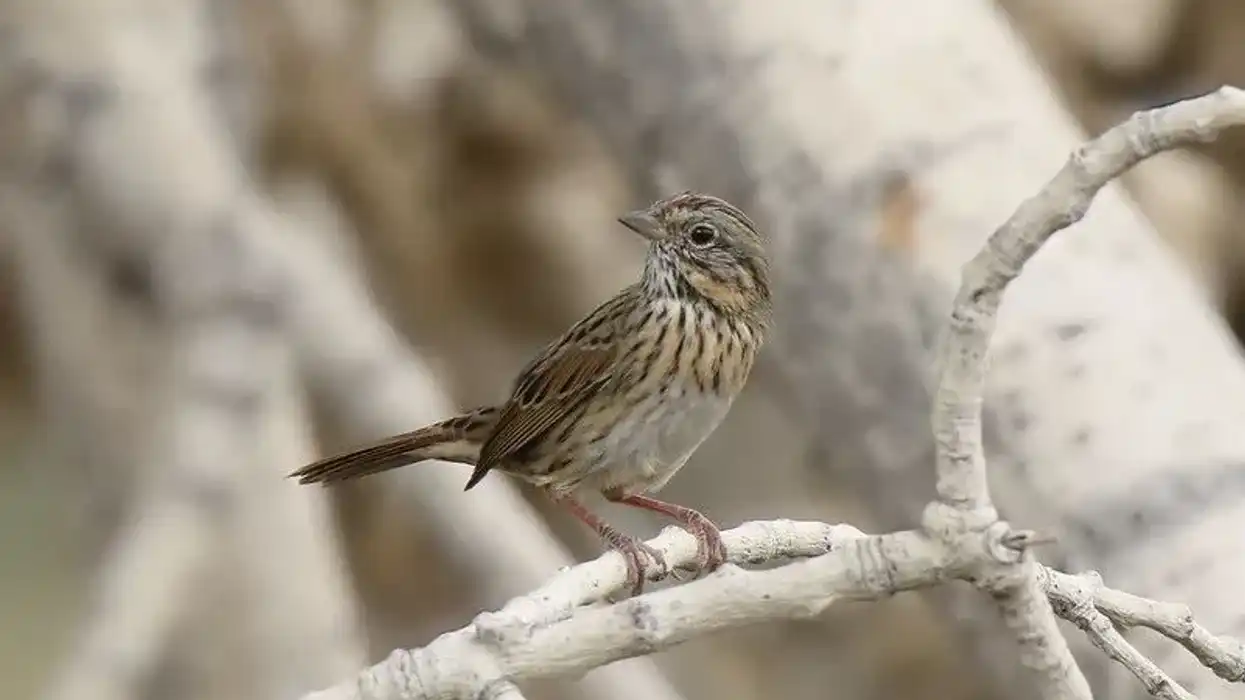The white-crowned sparrow Zonotrichia leucophrys is a common winter bird found in North America. It gets its name from the eye-catching black and white stripes lining its entire head region (like a crown).
There are five distinct white-crowned sparrow subspecies. While they are all found along the West coast at different times during the year, they vary in terms of their habitats, breeding, and migration habits. These subspecies may also exhibit mild differences in plumage and facial features (like the color of their bill).
This North American bird is a passerine, a songbird that loves to belt out a range of melodious, white-crowned sparrow sounds. Also, the white-crowned sparrow song of a male has a clever way of navigating his partner white-crowned sparrow female to their home territory.
A white-crowned sparrow is also known as a perching bird, as it loves to perch on trees. For this, it has a special toe arrangement, with three fingers pointing forward, and one finger pointing backward. This helps them stay stable when they are high up in the trees.
At Kidadl, you can explore several other fascinating birds and their subspecies, including magpie goose facts and Cooper's hawk facts.
White-Crowned Sparrow Interesting Facts
What type of animal is a white-crowned sparrow?
A white-crowned sparrow is a common winter bird.
What class of animal does a white-crowned sparrow belong to?
Like all bird subspecies, the white-crowned sparrow belongs to the Aves class.
How many white-crowned sparrows are there in the world?
There are an estimated 60 million white crowned sparrows across the world. Also, 80% of this population visit the North American (west) coast, sometime during the year.
While these are hearty numbers, the white crowned sparrow species lost almost a third of its population between 1966 and 2012. The present numbers are a result of increased awareness and commitment, to the conservation of this bird and its various subspecies.
Where does a white-crowned sparrow live?
This common winter sparrow is found in large numbers along the west coast of North America. The white crowned sparrow range is spread across brushy areas in the tundra, the taiga (snow forests), Rocky Mountains, and the Pacific coast.
What is a white-crowned sparrow's habitat?
White-crowned sparrows are found in brushy areas and have diverse habitats. These North American birds have five subspecies based on their biological classification (Gambelii, Leucophrys, Nuttalli, Iriantha, and Pugetensis.)
But it is more common for conservation groups to classify them based on habitat, as follows:
The dark lored birds: They are common in the Rocky Mountains, and have a pink-colored bill. They include the Iriantha and Leucophrys subspecies.
The Pacific birds: They are found along the Pacific coast, and have a yellow-colored bill. They include the Pugetensis and Nuttalli subspecies.
The Gambel's birds: They are found in taiga regions (snow forests) along the coast, and have an orange-colored bill. They include the Gambelii subspecies.
They also have varied migratory habits. The south population birds are mostly stationary, foraging within their home territories all through the year.
On the other hand, the Northern birds from tundra regions are known to migrate quite a distance during winter. For instance, the Gambel's white-crowned sparrow migrates from Alaska to southern California during winter. This is a sizeable distance of 2,600 miles (4,184 km).
Finally, this bird species is common along the West coast and is rarely sighted along the East coast.
Who do white-crowned sparrows live with?
They live in a large group of birds, called a flock. Each flock can have a hundred birds. This species also forages together with its flock.
How long does a white-crowned sparrow live?
The life span of this species is dramatically variable when they are in the wild. For instance, the average life can be as little as 16 months. However, the oldest bird recorded in this species was 13 years and four months.
How do they reproduce?
A white-crowned sparrow typically breeds during the spring to the summer season, when vegetation and food are available in plenty. These North American birds prefer to breed only once every year. But some subspecies have been known to breed multiple times during a year.
When in season, the males tend to reach their breeding grounds before the females. It is also their responsibility to look for a territory to build their nest. The nest is later built by the female white-crowned sparrow.
Once a territory is established, the male white-crowned sparrow calls out to their female partners, through their songs. Here, the specialty of white-crowned sparrow singing is the dialect contained within the songs.
Each bird territory has its own dialect, and this is reflected in the songs sung by birds in that territory. So when males sing their territory’s songs, their female partners are automatically guided to their family territory.
The females create a white-crowned sparrow nest using grass, leaves, and twigs. The nest-building process can take anywhere between two to 10 days.
A female prefers to create her nest in the lower region of trees. But due to lack of vegetation, females living on the Pacific coast (tundra region) may be forced to create their nest on the bare ground.
In this case, they may use additional materials like fine feathers and hair, and camouflage the nest to save it from predators.
Females can lay anywhere between three to five white-crowned sparrow eggs during a breeding season. They have an incubation period of 10–14 days. During this time, the males go out to forage food while the females remain within their territory to protect the nest. Once the eggs hatch, male birds branch out on their own.
White-crowned sparrow hatchlings are born with sparse but soft feathers, to help keep them light and warm. They also have brown and white stripes in their head region (as opposed to the conventional black and white stripe pattern). The brown hair gradually turns darker as these young birds grow.
White-crowned sparrow nesting habits may vary across subspecies. But they all have a minimum nesting period of eight to 10 days before the young ones leave the nest.
What is their conservation status?
The conservation status of the white-crowned sparrow is of Least Concern. This is not an endangered species as per the IUCN red list.
White-Crowned Sparrow Fun Facts
What do white-crowned sparrows look like?

White-crowned sparrows are small birds, with a gray breast and face, and streaked brown feathers. They are identified by the characteristic black and white stripes covering their head. This bird species has black eyes and a long tail. The bill is short and varies in color (yellow, orange, and pink), depending on the subspecies.
How cute are they?
Their cuteness is undeniably charming, especially when these songbirds set out to produce delightful melodies with their tiny lungs!
How do they communicate?
They communicate through a musical range of chirps, whistles, and tweets. They are also known for their songs. Males sing more often than females, to attract and call out to their partners during the breeding season.
You see, male birds tend to stay close to their flock family, within a territory. With this, the song of a white-crowned sparrow contains the dialect exclusive to its territory. So when males sing, female birds are automatically guided to their partner’s breeding grounds within their home territory.
How big is a white-crowned sparrow?
The white-crowned sparrow is 5.9-6.3 in (15-16 cm) long and weighs less than 1 oz (28 g). It is one-third the size of the popular robin bird.
How fast can a white-crowned sparrow fly?
The speed is variable, ranging between 40–90 miles (65-141 km) per day during migration. Nature groups have also recorded a single instance of this bird species traveling 300 miles (482.8 km), on the same day!
How much does a white-crowned sparrow weigh?
The white-crowned sparrow's weight ranges between 0.9-1.0 oz (25-28 g).
What are the male and female names of the species?
Both birds are known by the same name (white-crowned sparrows).
What would you call a baby white-crowned sparrow?
Baby white-crowned sparrows are called hatchlings. They may exhibit mild differences in their nesting habits based on their subspecies. But they all have a nesting period of 8-10 days before they leave the nest.
Young birds can be distinguished from adults by the brown and white stripes on their crown (as opposed to black and white stripes in adults). They are also known as juvenile white-crowned sparrows and immature white-crowned sparrows.
What do they eat?
White-crowned sparrows are natural herbivores when vegetation is in plenty, feeding on grass, weeds, seeds, grains, flowers, buds, berries, and fruit. They turn into omnivores during the summer, additionally feeding on a variety of insects.
Are they friendly?
Yes, white-crowned sparrows can be friendly when you tempt them with their favored food groups! They are also a social bird group and thrive living with their flock family.
But males can also get aggressive about their territories during the breeding season, especially when they perceive stranger danger. In fact, he expresses his displeasure at the stranger by singing loudly!
Would they make a good pet?
They can be good pets in theory, especially due to their straightforward eating habits. But they are a protected bird species. Unless you have a special permit, it is illegal to keep this species in captivity.
Did you know...
The best way to attract white-crowned sparrows to your garden is to grow sunflowers. Yes, these small birds love to gorge on sunflower seeds!
In what way are white-crowned sparrows loyal?
White-crowned sparrows display their loyalty in several ways. They are a monogamous species, often choosing to mate with the same partner all their life. They are also loyal to their territories, even if they are impermanent migration sites. In fact, these birds return to the same winter territory every year!
How far do white-crowned sparrows migrate?
This is variable, depending on the subspecies. For instance, south white-crowned sparrows are stationary, staying within their home territory throughout the year. There is also the Gambelii subspecies, which covers a distance of 2,600 miles (4,184 km) during migration. They travel from Alaska to southern California during winter.
Here at Kidadl, we have carefully created lots of interesting family-friendly animal facts for everyone to discover! Learn more about some other birds from our yellow warbler facts and white ibis facts pages.
You can even occupy yourself at home by coloring in one of our free printable White crowned sparrow coloring pages.









